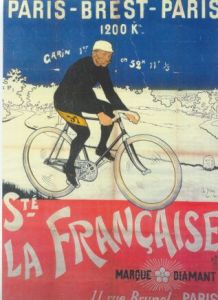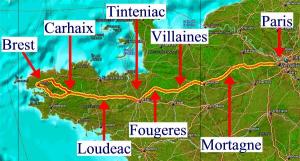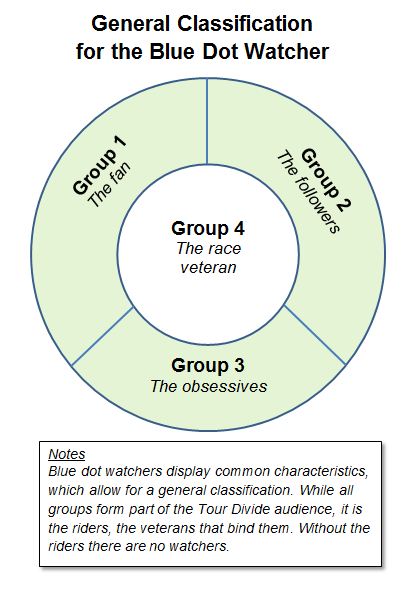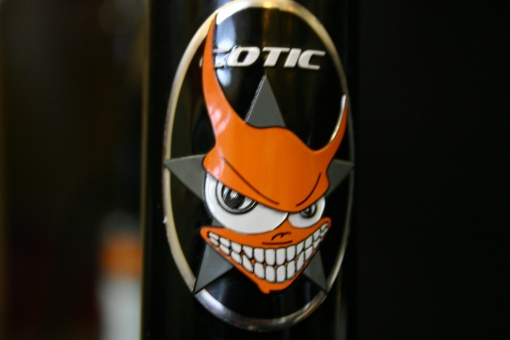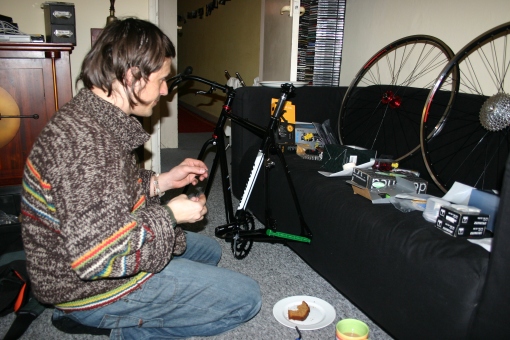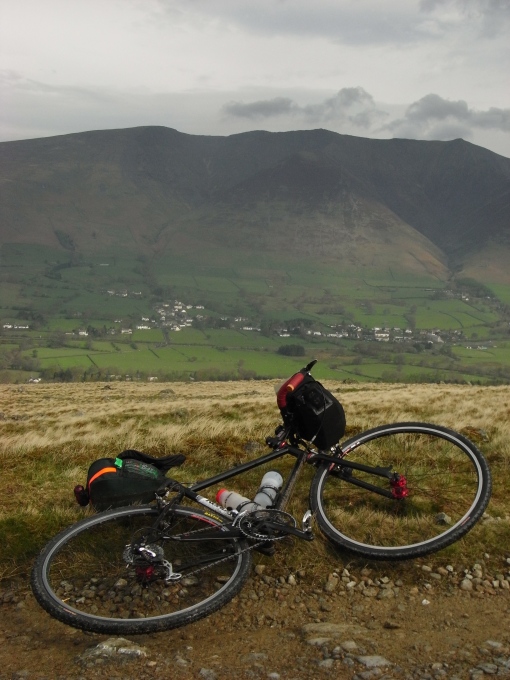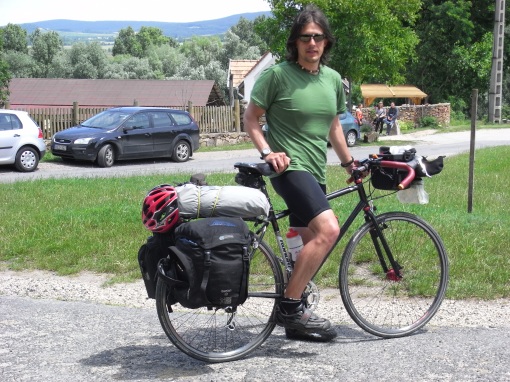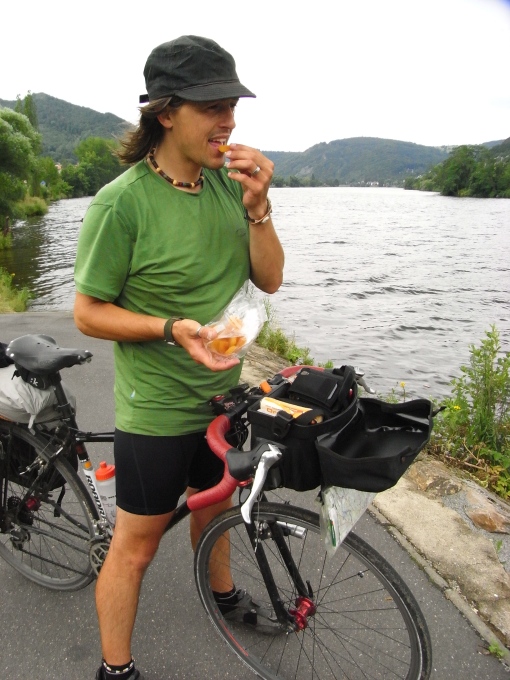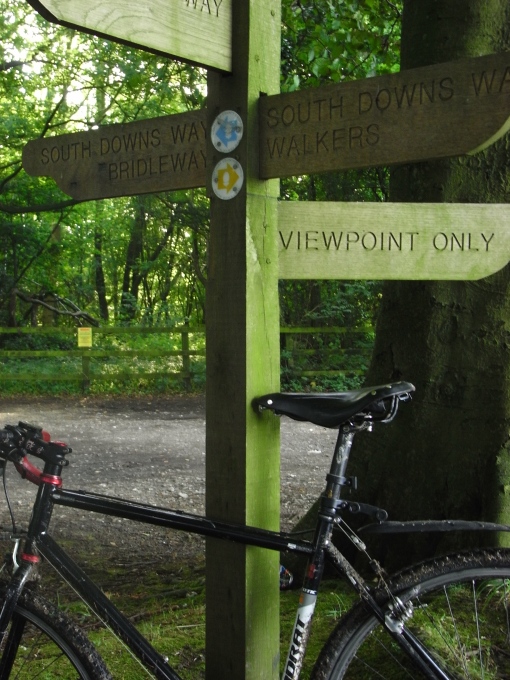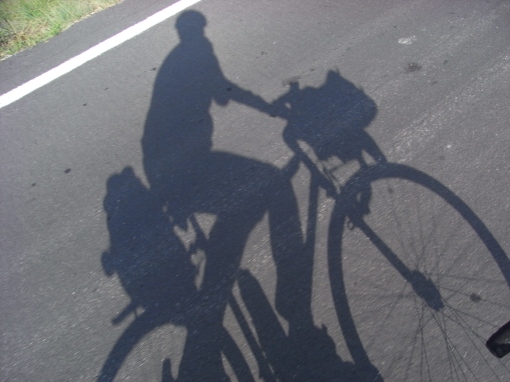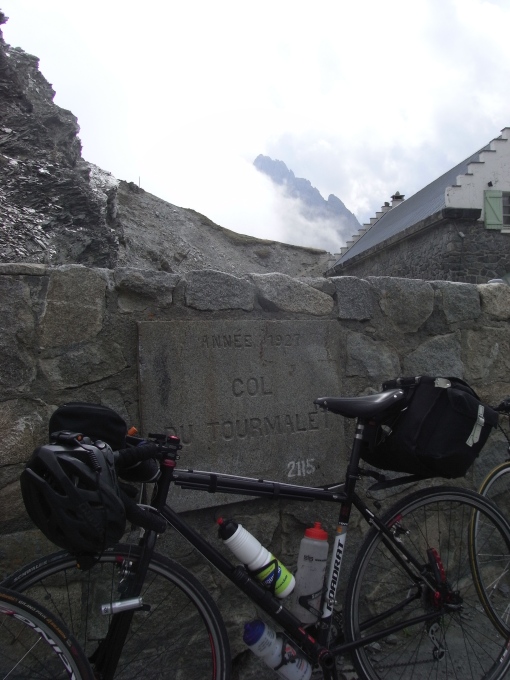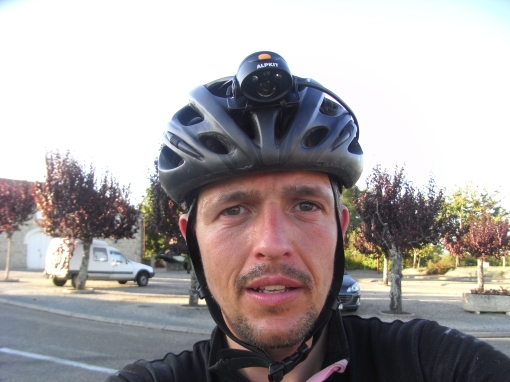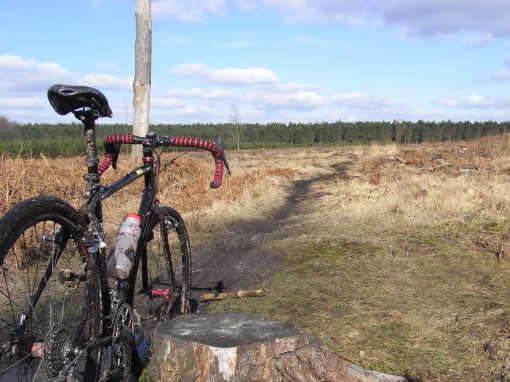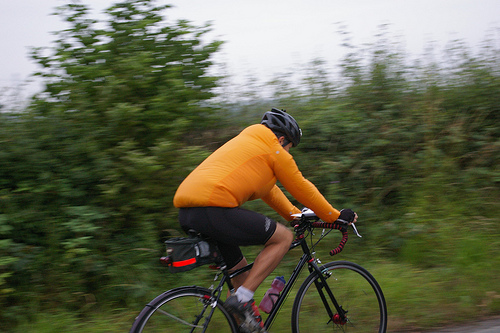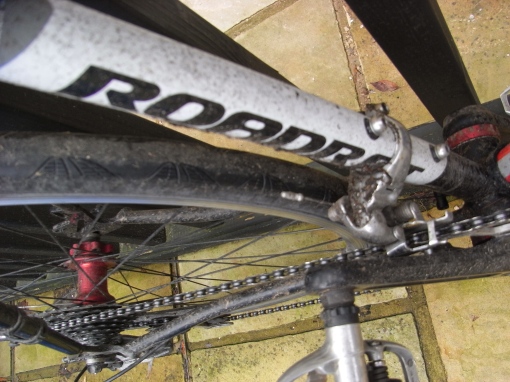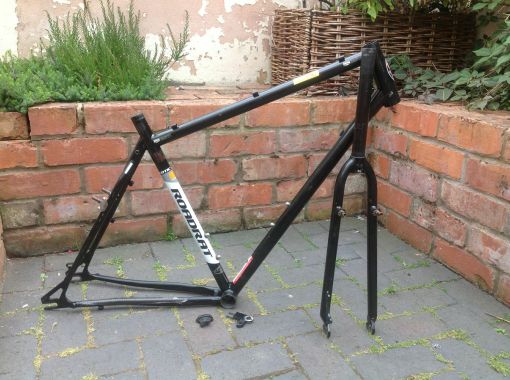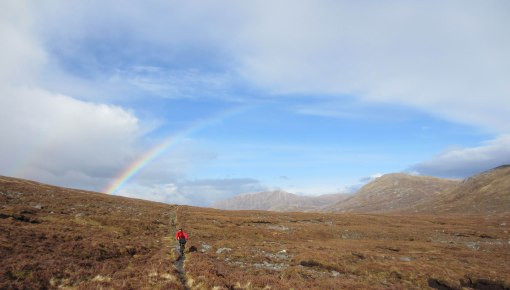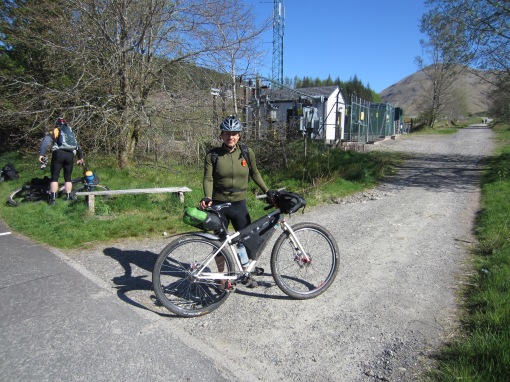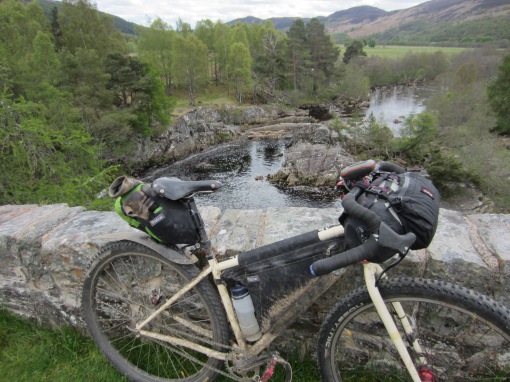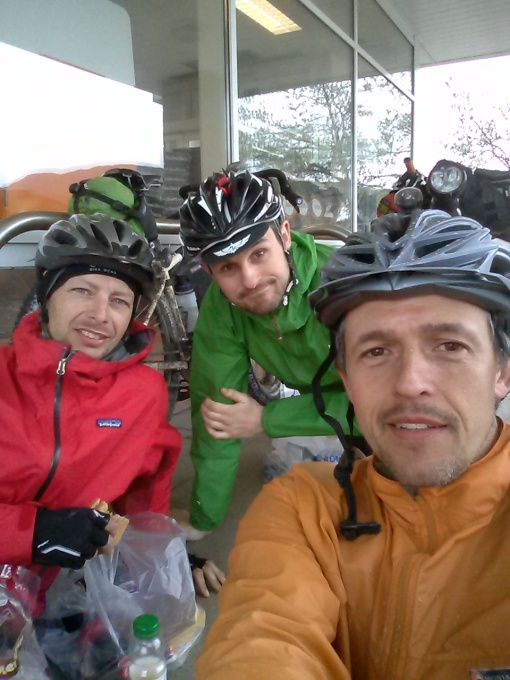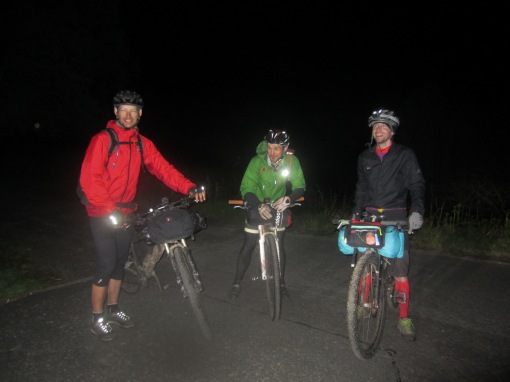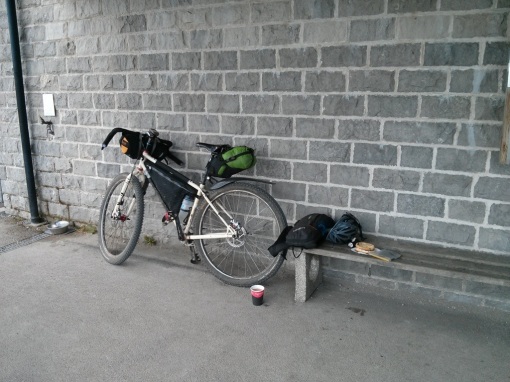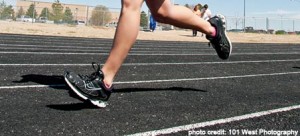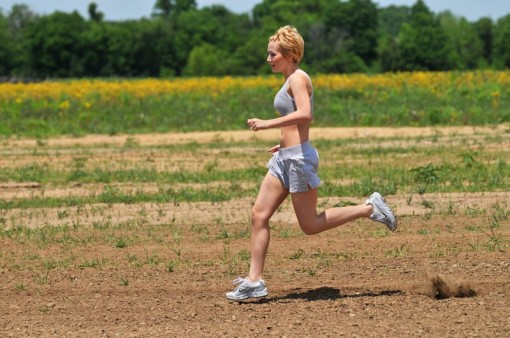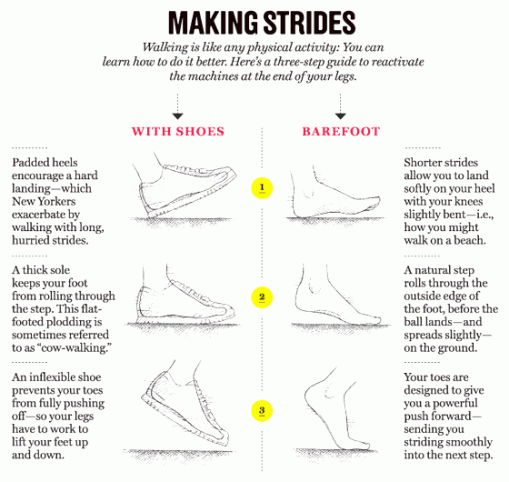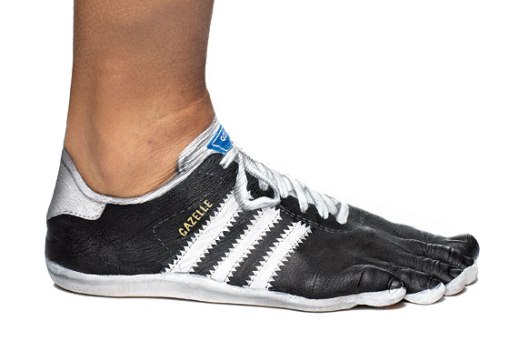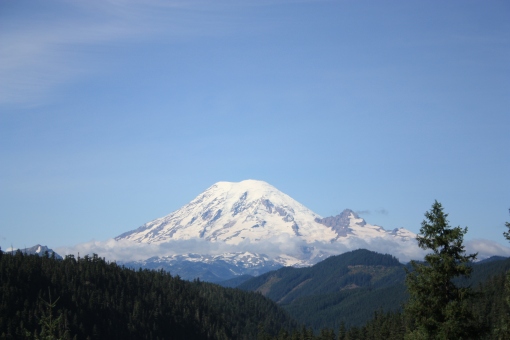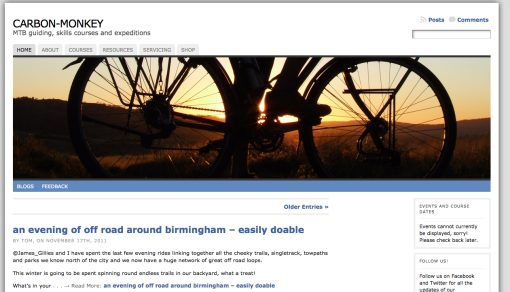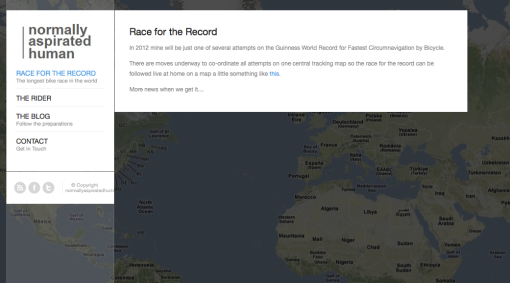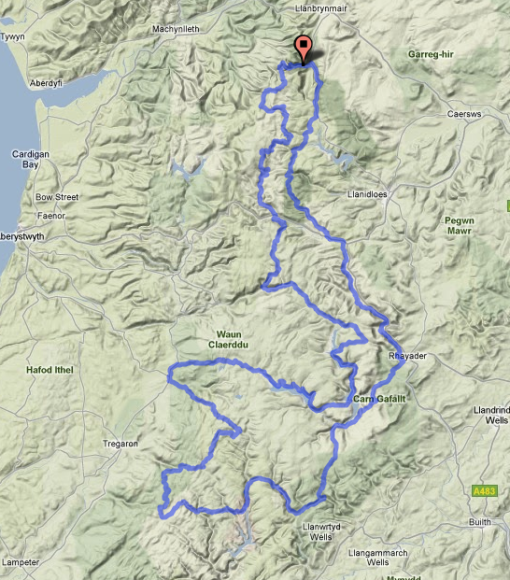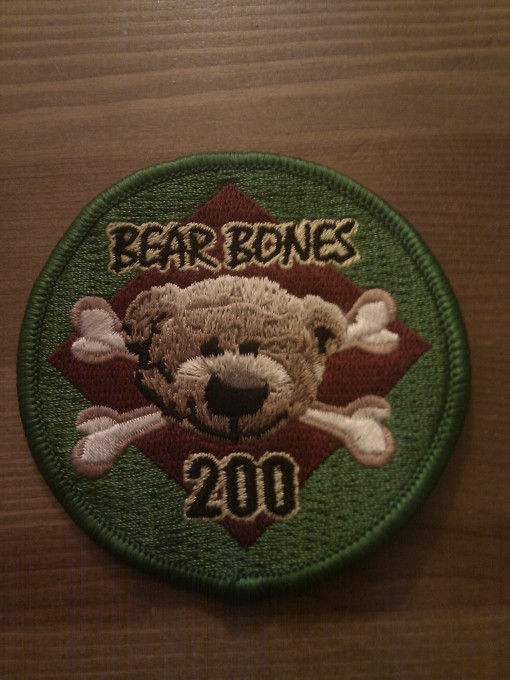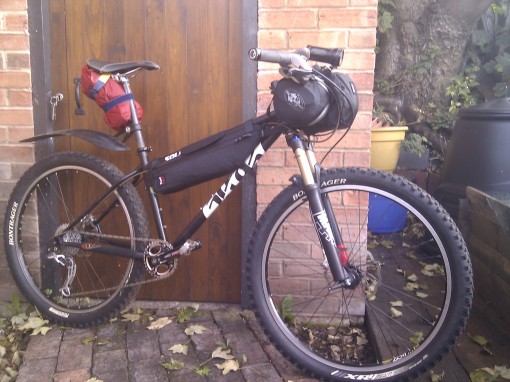Follow my ride in real time with Lezyne TRACK !
21 10 2016Comments : Leave a Comment »
Categories : James's Stories
Tracking test
8 07 2016I’ve found a way, theoretically, to track my rides. I’ve set up a test for tomorrows 300km audax. Follow the link below to track my ride, if it works!
https://spotwalla.com/tripViewer.php?id=1181b577f7191abbb9
Comments : Leave a Comment »
Categories : James's Stories
Paris-Brest-Paris 2015
23 03 2015Time to breath life back into the old blog! That can only mean one thing, well two actually. Firstly, that I’m planning a big ride, the journey of which is possibly worthy writing about and secondly, that the kids have backed off a little and cut Rach and I a bit of slack.
So the ride I’m planning is the Paris-Brest-Paris. A long distant cycling event that goes from Paris to well….Brest, and then back to Paris. Some 1400km (870 miles), to be ridden within 90 hours. Organised every four years, the first event being held in 1891, making it one of the oldest cycling events. To be honest, I’m not riding it for the route, by accounts its a little mundane. But what it lacks in topography it makes up for in atmosphere and heritage. It’s a ride to be completed at least once by any half serious long distance cyclist, of which I’m trying to be.
And I’m not alone, with several thousand other cyclists from across the world heading to Paris in August this year. It’s sure to be fun. But as with all these long events, its the journey to the start line where the adventure really lies. The consistency in training, the miles back and forth over Wales, the early starts, the Tuesday night hilly rides and catching up with cycling friends seen only once or twice a year. Good times.
Comments : Leave a Comment »
Tags: Paris-brest-paris, PBP 2015
Categories : Bike Adventures
A proposed general classification of the blue dot watcher
23 01 2014I’ve been following and dreaming of riding the Tour Divide Race since 2008, so when I was asked to submit an article for volume 5 of the Cordillera I said yes! The Cordillera is a collection of literature and art inspired by the worlds toughest bike race, the Tour Divide. Profit from sales of the Cordillera go to the college funds for the daughter of a rider who died on the ride a few years back. Below is my short article which made it in to this years edition:
A proposed general classification of the blue dot watcher
I’m a fettler, as I suspect are so many other blue dot watchers. But I’ve not always been. I blame this affliction firmly on my academic training and long distance cycling. The former taught me to analyse the world, to develop hypotheses and models to explain it. The latter has seen me spend hours thinking about different ways to attach route instructions to my bars, pondering the effects of tyre pressure on saddle sores and the calorific and nutritional content of petrol station food. Both require an attention to detail, the ability to problem solve, to reflect at length, to fettle with ideas and things, to classify approaches and solutions.
The hours of attention that blue dot watching requires, means that like other areas of my life, it’s also became the subject of a classification.
By reflecting on my own experience and that of others, I propose a general classification of the blue dot watcher for consideration. I have to caveat my reflections by acknowledging that ‘us’ blue dot watchers are a breed apart from the general public. What turns us from a normal person into someone that eagerly awaits that few weeks in June when we watch a series of blue, pink and maybe other colour dots travel along a red line marked on a google map, is not discussed in this musing. I see that there are four basic groupings that a blue dot watcher can fall into.
Group one. Up until this year I myself have fallen into this category. We are the avid fans of the tour divide (other blue dot events do exist). We don’t know anyone personally that is doing or has done the ride. We have not ourselves completed the event, but many of us would probably like to. We watch the dots, listen to some of the mtbcasts and read the forum trying to imagine the people and stories behind the dots. We develop our own theoretical race plan for when we get to be a blue dot ourselves. Maybe we look for a connection to some of the dots to better allow us to imagine what it’s like to be out there. I always look out for the Brits, but also follow the single speeders. Our emotional attachment to the race is that of an avid fan so on the whole we are looking at the big picture, the general flow of the race, have a real interest on the front runners along with our selected riders.
Group two. This year I fell into this category. We too have not competed in the TD, but would like to. However, we know a person behind one of the dots, not very well, but we know them. Maybe as for me, you trained with and had your arse kicked by them during a few cold winter months. They are not close friends or family but you know their smile, know how they talk and maybe know what it looks like to watch them disappear up a hill in front of you. This means that you have an idea of the story behind one of those bluedots and as such their dot becomes the most important one in the race. You’re still interested in the big picture, what’s happening at the front, maybe even still lookout for fellow countrymen, but you now have a reason to focus in on some detail. The TD suddenly takes on a new level of interest, you update more frequently, you use the bluedot phone app, you use satellite view to look at the towns, roads and landscape they travel through. Anything that allows you to also be there.
Group three. In many ways I feel sorry for this group. I’ve heard their struggles on the forums and been told first hand why they would rather not be blue dot watchers again. This is the group that have close family and friends in the TD. I was a blue dot in the Highland Trail 400 this year and my wife became an obsessive member of this group. I can only imagine what it would be like for her if I actually went to Banff and became a dot for several weeks. This group have a level of obsession that goes far beyond that of the previous two. They will stay up until the very early hours to make sure their loved one has bed down in a good spot for the night. They will shout at the computer if their dot goes the wrong way, or if another dot is catching up. They will worry like hell if the dot stops without explanation or communication for hours on end. They know the story behind the dot, but at times they would rather not. They don’t care that much about the big picture, they might look at the front of the race but are more concerned with the dots immediately in front of and behind their loved one. This group is also unique in that before their son, daughter, husband, wife, etc became a blue dot they themselves were not blue dot watchers. It is also unlikely that they will watch another blue dot again once it’s all finished. They do not necessarily come equipped with the background TD knowledge to make sense of the events as they unfold. As a result, you will find them on the forums being advised by members of group one, two and four.
Group four. This categorisation is reserved for the small but ever growing pool of TD veterans. They have been out there. They know what it’s like to plan the ride and finally roll out and down the trail from Banff. What it takes to keep the spot tracker signal going for the folks back home so they have a blue dot to watch. On the forums they tend to be the calmest of posters, the ones with the wisest words for those in group three. Maybe with all the build up to doing the TD, they themselves once having been in group one, possibly group two, having put their close friends and family through group three, they then back off from the event. It becomes less romantic to them.
That’s my four groups explained in brief. There maybe other groupings or you may consider my proposals to be wide of the mark. This is to be expected. I wish to start a discussion. Regardless of our grouping, we can can be sure that ours is a strange sport to spectate, unique even, given its grassroots amature nature. The ITT rules all but exclude us from watching in person and there is no corporate interest. Despite this the race directors and others have used technology, through phone ins, forums and satellite technology to create a truly unique event to spectate. In the processes they have created a bluedot following which itself needs to be increasingly managed. Like it or not we have become as much part of the TD experience as the riders themselves.
I wish to thank Mike Hall for putting me in group 2 during the 2013 TD. It was riveting!
James lives in Birmingham, UK and will be a group 2 blue dot watcher again during the 2014 TD.
Have fun Greg!
Comments : Leave a Comment »
Tags: Blue dot watcher, Tour Divide
Categories : James's Stories
Goodbye trusty steed: The Roadrat’s obituary
22 07 2013I go through an odd set of emotions when I decide to sell a bike, or frame. Unlike many of my cycling peers, I never had a great stable of bikes at anyone time, and haven’t actually owned that many bikes. The process of picking a frame and it’s components is usually long and drawn out. How am I going to use the bike? What components to get? How much will it cost? How am I going to fund this project? As a result, I tend to keep bikes for a good few years and have many adventures on them. This builds a set of emotions and feelings for the bike. I become attached to them. So when the day arrives that I finally decide it’s time to move on, it’s not a decision taken lightly and involves a fair bit of pain. It’s like loosing a dear friend. So when on Saturday I decided to place my Cotic Roadrat frame on a well-known internet action site, only to have it bought within an hour, I thought it fit to write an Obituary of sorts to remember the adventures we’ve had together.
During 2007 I had been thinking about putting together a bike for a mixture of uses. It would be asked to do long distance road rides, touring and some light off-road use. It would need to take skinny slick and knobbly tires, have the option of either cantilever or disc brakes, be well-built and be a little bit different. I had looked at the Surly Crosscheck, the Soma Doublecross but I’d also spotted the Cotic Roadrat and the frame fitted the bill. But there was no way I could justify the cost of such a bike at that time to be honest. However, Rach and I were getting married May 2008, and for our honeymoon we’d decided to go for a two month bike tour around central Europe and neither of us had suitable bikes for the trip. So we agreed that new bikes would be our wedding gifts to each other. The Roadrat was born and specked to be hard-wearing. I picked a range of components that crossed the mtb and road world. Hope pro2 hubs, bottom bracket, headset, DT swiss rims and spokes, spooky cantilever brakes, to be upgraded to cable discs after the honeymoon (which never happened). Ultegra 9 speed brifiters, XT rear mech, 105 front, Sram mtb cassette, Race Face cadence compact chainset, with an array of decent finishing kit including On-one midge bars and a Brooks B17 saddle finished it off. It was a sexy built to last bike put together in my lounge.
By April 2008 I had a finished bike. What a great feeling. Having a brand new bike with shiny new parts awaiting its first ride of discovery.
It’s first proper adventure was my stag-do. Yes, I went cycling for my stag-do, and with only one friend, Simon. At the time I only had one friend that would want to cycle the sustains coast-to-coast route over 3 days including the off-road sections. So I strapped on some luggage, fitted knobbly tires and off we went to cycle across the county and drink some beer on the way. What I didn’t know at the time was this ride was to be my very first bikehiking trip, something I love doing now.
The trip was a success and the bike performed without fail. The next trip was our Honeymoon. Two months around central Europe. Rach and I covered 1600 miles and crossed Slovenia, Hungry, Slovakia, Poland, Czech Republic and East Germany. The Roadrat was loaded with bike camping gear and new kit for the trip, and again performed brilliantly.
I still think that was the best two months of my life. Travelling on a bike I loved riding and with my best friend who was now my wife. My two favourite things! But those two months came to an end and we were back home, but the adventures continued. First up early August 2008, I stripped the luggage off, put the knobbly tires back on and rode some cheeky trails on the Worcestershire Way.
This was followed by an attempt on the whole 100 miles of the South Downs Way, again with Simon. It had been Simon’s childhood dream to ride the South Downs Way in one go. It was not to happen on this occasion, we made it to about the 80 mile mark before we ran out of light. We would return during May 2009 and finish the distance but this time on mountain bikes.
It was during these long off-road rides using the flared drop midge bars that I started plotting my next bike. That plotting would ultimately spell the end of the Roadrat but more on that later. For now, the Roadrat was being used for another type of adventure, audax. Somewhere during the end of 2008, Phil, a cycling friend at work, asked if I fancied entering the London-Edinburgh-London audax. At 875 miles, I hesitated and then entered. Phil didn’t enter. The ride was at the end of July 2009 so I had about 7 months to train. This was a major undertaking. I’d decided that buying and training on a fixed wheel bike would be a good idea so through the bike to work scheme I picked one up during December 2008. Indeed I rode all my training rides up to 400km on the fixie but the long 600km rides and the LEL itself I would use the Roadrat. It’s odd, but I don’t have any photos from those long rides. I suppose I’d decided that taking a camera would not help me finish any quicker! So during June and July 2009 I put in about 1200 miles on the Roadrat over two very long hard rides. The LEL was a monster but we finished without fault, but having ridden my lighter road specific fixed gear bike all year I was starting too see the flaws in my choice of kit for the Roadrat. It was just a little too heavy, a little too robust and a bit too stiff for fast long distance road rides. What it did excel in, was being fitted with wider tires, a little bit of kit and being taken on multi-surface adventures. And that’s what it’s next trip was all about.
Having been in training to ride long distances and in need of a holiday for 2009, I decided it would be a good idea to spend two weeks riding the 1600 miles from Birmingham to Almeria, Southern Spain to see my cousin. Rach, would have her own adventure and go overland by train and we would spend a week relaxing before flying back. So some more kit was purchased, namely a bivi bag, light weight tarp and ultra light sleeping mat and I headed off early September 2009 to churn out 150 miles a day for about 12 days.
It was an awesome trip! The highlight being two days of Col bagging in the French Pyrenees. The bike was set up as light as I knew how at the time (I’d make big changes to the set up if I did the trip now). I met great people on the way but the daily distances broke me and I suffered from solitude. Again the bike performed wonderfully, if a little heavy, but I was grateful of its build quality when tackling unsurfaced Spanish roads.
2010 rolled in and I was still using the Roadrat in multi-terrian mode to muck about off road. The Roadrat really suited the knobbly tires. I’d used it for the 2009 HONC, and again in 2010, coming close to a win both times.
But it was the 1000km Mille Cymru that was the main target for 2010. Again most of my training was done on the fixie except for the last month when I went back to the Roadrat in road guise to get used to using gears again.
I smashed my way round Wales putting in 3 back to back 230 mile days with over 14,000 meters of climbing. It was a hard ride, possibly my best ever to date. I don’t think I’d ever been that fit before or that fit since. By now the Roadrat was starting to get a little tired. Other than new cables and pads, I’d only changed the chain once but hadn’t needed to do any other real maintenance. By the time Spring 2011 came round a number of the components needed some love. The headset, rear hub and bottom bracket bearings had seen better days, I needed new cables, pads, bar tape and tires. All this corresponded with Rach and I saving to buy a house. Money was not flush and the Roadrat hung on the wall waiting to receive some love. I’d also decided to turn my attention to long distance mtb rides, and didn’t have any tours planned. The Roadrat became a bit redundant as my first choice for road rides was always the fixie. Being lighter, having less to maintain and ultimately better suited to ride rides, it was always picked in favour to the Roadrat. Off road rides were done on the mtb as it was always quicker over technical terrain.
The Roadrat’s final big adventure was made during the summer of 2011 where it went from London to Brussels in 24 hours leading a group of charity cyclists. It was a fun ride, and one that suited my cycling style. Not much happened with the Roadrat after that point. After three solid years of adventures covering 6-7000 miles the Roadrat slowly went out of favour as I turned increasing to my other two bikes.
Through late 2011 and into 2012 the Roadrat was used for little more than the odd snow ride and occasional 3 mile commutes to work. We had our house and Adam had been born so money and attention had been diverted elsewhere and the Roadrat’s list of requirements went unmet.
But it was a new frame that marked the end of service. I loved riding the Roatrat off road with knobbly tires and flared drop bars and this set up had long convinced me of the merits of a 29er mtb, maybe even one designed for use with flared drops. I’d had my eye on a Salsa Fargo for a few years but in the end I was given some money and bought a Singular Gryphon frame and forks. The Roadrat was stripped, the components serviced and fitted to the new frame. During August 2012 my long distance 29er, rigid, single speed, flared drop bar, bike packing mtb was born. It’s the logical evolution of all I loved about the Roadrat, namely the off-road adventures, but it’s just a lot more rugged.
And despite all the long distance road rides I had tackled on the Roadrat, it never really excelled in that function. Sacrificing the Roadrat to build the Gryphon confirmed that to me. So from August 2012 until last Saturday the Roadrat has hung in the shed awaiting it’s next adventure. Every time I saw it just hung there, looking a bit sad, it brought back the memories of the adventures we’d tackled together. And that me feel guilty, that it’s destiny was to wait until I decided to bring it back to life with a new set of components and a new function. But deep down I knew that was unlikely to ever happen. The Roadrat deserved more than that. So it was with a sad heart that I decided to sell the frame and therefore open up a new line of adventure for the Roadrat in someone else’s care.
Of course, I’m planning a replacement. I have been since 2009. A bike that will follow the long distance road ride spirit of the Roadrat. A perfect stablemate to the Gryphon, with its off-road focus. It will share many of the same core requirements as the Roadrat, such as disc brakes, comfortable, stable to ride, versatility, not shy of some rough road action if required. But this bike will be much lighter, more forgiving and less rugged. It will not be used for loaded touring, the Gryphon can do that, but will be fitted with light weight luggage. I’ve my eye on a few possibilities from Salsa, Shand and Lynskey. With thousands of miles of long distance solo road rides under my belt I’ve had plenty of time to ponder the build. I know what I want, I know what I don’t want. I know every component to be used, who will build my wheels, what brake pads I will use. This bike will be a keeper. Problem is at this point in time there is no way I can justify the cost. But I’m 40 in the not so distant future and I’ve a few long distance road adventures on my radar, the 2015 Paris-Brest-Paris, the 1001Miglia and the Transontinental Race. So who knows?
Long live the spirit of Roadrat!
Comments : 3 Comments »
Tags: Cotic, Roadrat, soma doublecross, surly crosscheck
Categories : Bike Adventures, James's Stories
Highland Trail 400 – reflections
12 06 2013It’s been over 2 weeks since the race ended for me, so it’s time I finally thought about putting some words to paper. However, to be honest I don’t really have the will to write about it. I’d spent a good 6 months thinking about this event. It was to be this years ‘big ride’ before I focus my efforts on running over the next few years. It was the first bike-packing race I’d entered as most others take place in the states and as such are prohibitively expensive for me to ride. But I’ve been thinking about having a go at such a race for 5 years now, ever since I first discovered the Tour Divide. Every long distance ride, every Tuesday night blast with Rich, every bike-packing trip with Simon, every night in my bivi bag with Rach over the last 5 years has been with this in mind. And when it came down to it, I had to pull out before the end because of a snapped spoke on a very kindly lent wheel. Thanks for that wheel Tom. I was GUTTED, and still am if I allow myself to think about it. So instead of writing too much about the Highland trail 400 in this post I thought I’d muse on bike and kit set-up the choices I made and how it worked out for me.
So this is me and my bike.
I ride a Singular Gryphon. Yep, it’s single speed has drop bars and no suspension. And it worked really well, except for the snapped spoke that is. Wheels aside (an upgrade to arch ex rims, on hope hubs running tubeless is on the cards), the bike is built around parts poached off my touring/CX bike. Usual kit, decent but not silly expensive. Hope headset, bottom bracket, hubs, all easy to service and proven time and time again. Race face cadence cranks because that’s what I had. 34t steel surly ring, 19t steel surly sprocket, KMC Z610 chain, that are all hard-wearing and look nice when clean. Avid bb7 road disc brakes because, well that’s about the only choice really with the drop bars. Cane creek SCR-5C levers. I like the shorter reach levers and the little lizards on the hoods are cute. Avid full metal jacket brake cables because they work. I was running a 2.2 continental king-x protection on the rear and a 2.35 schwalbe nobby nic on the front. Both had tubes and a little sealant and it performed without fault.
The rest of the kit is a little more, well, odd. Salsa Woodchipper bars, wrapped with salsa bar tape (that I won’t be using again, to stretchy) and over wrapped with black cloth tape. I love these bars, the angle of the flared drops are perfect and are oh so comfortable! There is plenty of space to move my hands back and forth and the width provides plenty of leverage on the climbs and stacks of control. At no point did my hands or wrists ache during the ride despite my lack of suspension. I think running a 2.35 front tire helped. However, I’m thinking of giving Jeff Jones H-bars ago as I’d like to be a little more upright than I currently am but don’t want a massive pile of spacer’s and a silly steep steam. The HT400 promised to have a lot of hike-a-bike which in Scotland could only mean rocks. I didn’t fancy walking miles in stiff cycling shoes with a nice shiny cleat slipping on the rocks. So I opted to wear my Inov-8 315 trail shoes. I paired them with flat peddles and Power Grips. I’ve been riding on this set-up for 3 months and found it to work well. There’s no real noticeable loss of cycling efficiency, out of the saddle single speed honking is a little odd, but fine really and walking was a pleasure. I had no problem with this set up on the HT400, and unlike some other riders my feet did not hurt. Finally I opted to use my beloved Brooks titanium swift saddle atop a BBB carbon seat spot. The swift usually lives on my fixie for road duties but I know it to be very comfy.
So on to the bike-packing kit. First up the electronics. I use a Garmin Dakota 20 GPS with open street maps. I like that it uses AA batteries, and the unit has proved itself to be reliable over the last few years. However, if I was buying new now I’d have to consider the Garmin e-trex 20 because of it’s massive battery life. I had an Exposure diablo helmet light and a triple piggyback so I could happily ride into the night. Which didn’t really happen. I also have another small white LED for camping and a flashing red LED for roads both on my helmet. The only other item was the spot tracker.
I used a Revalate Designs sling and large pocket. I see that Eric has updated his designs for both now. The sling holds a Sea to Summit XS compression dry bag into which I place a PHD minius 300 downbag, with full zip and pertex outer, a silk liner and a Montane prism primaloft jacket. This kkeps me warm to about -2 degrees and full zip allows for plenty of warm weather ventilation. The sling is used to carry food and Elete electrolytes. I’ve recently had a wildcat gear frame bag custom stitched to fit around a travel tap water bottle with a removable water filter. The frame bags main pocket holds two spare tubes, basic tool kit (that did not include a spare spoke) basic first aid kit, pump, midge spray, spare batteries for GPS and spot tracker, the piggyback battery, the travel tap water filter, very small lock and my buff. The bag was not full so I didn’t have worry about careful packing and had extra space for food if needed. In the smaller side pocket I kept route cards and my camera. I also used a wildcat tiger harness to carry an 8l alpkit airlock drybag. Into which went my Rab ascent bivi. I like this bivi bag, whilst its not the lightest it’s well made, robust, breaths very well, can be fully closed if the weather’s bad, has a built in bug net (handy in scotland) and doesn’t cost the earth. I also packed into the saddle bag some heavy weight extremities windproof gloves, full length pertex trousers a Smelly Henson long sleeve top, Embers 3/4 merino tights, Hilly calf compression socks, lightweight Seal Skins, some light weight Rapha merino liner socks and a pair of thicker Hilly running socks. I like my socks! I get cold feet. This stuff was used for sleeping in and could be used as extra layers on the bike if the weather turned proper nasty. Finally I also carried a lightweight TOG24 8l backpack. I placed my Montane DT waterproof jacket in an outside mesh pocket for easy access. In the zip pocket I carried my tooth brush and paste, small pot of tee tree oil (antiseptic and smells nice, good for wet, smelly feet) butt maintenance kit (sudocrem), phone, emergency thick blue latex gloves. Great stuff sudocrem, can be used to smooth and ease blisters on other parts of the body besides your arse. I like to have these things to hand when I go into a toilet. I also stashed my small Bozeman Mountain’s Torso-Lite sleeping mat (now discontinued) on the bag, but the bag was essentially empty and used for food storage.
Finally I wore Endura MT500 3/4 bib knickers, a thin Ibex merino vest, Shutt Velo mtb merino perform jersey, with a Montane featherlite smock, Spcialized BG gel mitts with Rab primaloft liner glove. The smock and liner gloves were stuffed into the framebag when not worn. As mentioned I wore Inov-8 315 trail shoes with Embers merino socks, but the socks were put in the bin after the first day as they were threadbare and I wore either the Hilly running socks or seal skins thereafter.
So that’s it. The kit could be lighter but I don’t have a bottomless money pit so it all strikes a balance between cost, function, weight and durability. Maybe I should have just made a kit list instead of rambling on but hey ho. I used everything I wanted to use and nothing I didn’t want to use. By that I mean my rain gear stayed packed away (DT jacket, pertex trousers, windproof gloves), along with my first aid kit, spare tubes, pump and midge spray. I only used the water filter once as in most cases clean water was easy to come by. I would bring it all with me again, as this is Scotland and I’ve been proper caught out by the weather during late May.
As I said, I’ve not talked about the ride, that might happen another time but despite my failure to finish I had a great time whilst the ride lasted. I meet some great guys, we struggled through some amazing landscapes and laughed at the stupidity of traversing the stunning fisherfield countryside. Thanks to Greg, Tom, Daniel and Arno for a great ride.
I do hope to return as I’ve some unfinished business. Maybe next time I’ll get to finish like these guys.
Comments : 2 Comments »
Tags: Bikepacking, bivi bag, HT 400, power grips, single speed, singular gryphon, wildcat gear
Categories : Bike Adventures, James's Stories
Highland trail race – nearly ready to roll
14 05 2013
I’ve already floated around that I’m doing a race organised by Alan Goldsmith in Scotland at the end of May. It’s the Highland trail 400 http://www.highlandtrail.net. Some people I tell about it can’t understand why I would want to use annual leave to race 430 miles mostly off-road round the highlands of Scotland whilst sleeping behind walls and rocks. But as most of you know, I kind of like that sort of thing. The best way to explain the race is to list the rules:
– Complete the entire route, under your own power – no drafting
– Be completely self-supported throughout the ride – absolutely no support crews, absolutely no gear sharing
– Only use commercial services that are available to all challengers – no private resupply, no private lodging
– If you have to leave the route, you must rejoin it at the exactly same spot
– No caches of any kind
– No pre-arranged support, which means before you begin your ride – e.g. booking a B&B, arranging to meet a vehicle
– No travel by any motorized means during your ride – by all means do so if necessary, but understand if you do your attempt is over
– Gear – nothing required, nothing prohibited
This does not explain why anyone would want to do it. I guess you either get it or you don’t. You will also note that its not a very spectator friendly format, not in the normal stand along the side of the road and cheer sort of way. However, there is a solution. Most of the people racing will be carrying a GPS tracking device that will send out a signal every 10 minutes. Everyone’s position will appear as a blue dot on a google map. So you can follow race progress from the comfort of your nice warm sofa, or on your mobile in the office on Monday. As soon as I have the link I will post it on here as well as Facebook and twitter. Please follow us, but be warned it can be addictive.
Preparation has been going well. Ive been honing my online shopping skills, reading OS maps with the occasional bike ride thrown in. I’ve even spent the odd night sleeping in church yards and behind dry stone walls. I don’t expect to win, or even come close, as I’ve not been able to train as much as I think is required to really stand a chance. Also of the 30 riders expected to start, many have done this sort of thing a good few times before. It’s going to be a race with many of the UK’s best ultra bike-packing racers, which in itself I’m excited about. However, whilst I’m not going to win, I hope to not come last because I’m going alright at the moment.
I’ve still a few things to do to the bike, like change tires and grease up the chain but I’m about ready to roll. The race starts at 10am on Saturday 25th May from Tyndrum, and the first person may be done by Monday. We shall see. If your interested this is my bike setup.
UPDATE
The trackleaders page is now live. You can follow the race by clicking the link below. Remember it starts at 10am on the 25th May.
Highland Trail 400
Comments : Leave a Comment »
Tags: Bikepacking
Categories : James's Stories
You walk and run wrong
23 03 2013Last year when out on a Tuesday night ride with Rich (a good cycling buddy) he asked an innocent question near the beginning of the ride “I’m thinking about running an ultramarathon, want to join me” naturally I said no. After years of recurring running injures, I decided to stop running and just ride my bike, I don’t get injured cycling. I made that choice about 5-6 years ago. Seems Rich knew me better than I thought, by the end of the ride I’d taken what I’ve learned about long distant cycling, turned that in to a training plan and had agreed to give it go. I was going back to running.
With a 40 mile event identified we signed up and started our training. It was during my first run with Rich that it happened. “You know James, you’re a real heel striker” Rich is a physiotherapist with an interest in running and cycling injuries. I didn’t really know what he meant so we chatted and I read around a little. Seems there are different ways to run, and walk for that matter. A heel striker will usually have a long stride and their heel will hit the ground first somewhere in front of the knee, such as the runner above. A mid foot or forefoot runner will have a shorter quicker stride, and land on their mid foot usually under the knee.
So what? Well, having the heel land first, so the theory goes, is an unnatural motion, you are slowing yourself down every time your foot hits the floor and putting a lot of stress up through your legs. Mid foot runners, have a lighter step, don’t have that braking motion and use the bodies natural biomechanics to take the shock. It’s simply a better way to run.
So I attempted to run differently, to shorten my stride, and continued to read. The ultra marathon approached, Rich and I were doing marathon length off-road training runs where we would talk about running style. It was like being back in the pool learning to develop an efficient swimming style. Thinking about form gets addictive. Then 4 days before the ultra I picked up an injured and had to pull out of the race. Despite that I went to the start on my new bike to ride the route whilst Rich ran the 40 miles. It was a fantastic December day in the Beacon Beacons, frosty, clear sky’s, stunning.
Rich only made it to mile 10, he turned his ankle over on a downhill section and had to pull out. So we both have unfinished business with that run and plan to head back next December. However, I stated to read a bit more. I picked up a copy of ‘Born to Run’ by Christopher McDougall. A fascinating read that takes you in to the world of barefoot running, ultra marathons and human evolution. The theory goes that as a race of animals we are a bit ‘pathetic’ really. We are not that strong, don’t run that fast, can’t climb that well. So how did we survive, what was our evolutionary advantage that allowed us to thrive? Seems that we are good at sweating and we can run very long distances. It means that in hot climates we can run down other animals because they cannot sweat. When they get hot they have to stop to pant to cool down (think about a dog on a hot day). If you keep startling an animal and keep it moving, it doesn’t have the opportunity to cool down and in the end will collapse through heat exhaustion. Simple.
The book also explores running injury and design of modern shoes. Simply put it would seem that the more ‘engineered’ a shoe i.e the thicker and stiffer the sole, the more padding then the more likely runners are to heel strike and the greater the incident of injury. Conversely, those runners that use minimal shoes or no shoes (this includes a number of tribes across the world) are more likely to run on the mid & forefoot and pickup less injuries.
So what’s going on, it’s not what I would have thought. Again the theory goes that the foot is an amazing piece of biomechanics, engineering for barefoot walking and running. Far from needing shoes to give them support to function correctly, modern over engineered shoes actually work to reduce the foots ability to feel the ground, reduced it’s ability to move naturally and reduces its natural strength. We end up becoming heel strikers because we have a great piece of padding protecting our feet. If you don’t have that padding then it hurts to land on your heel so you don’t! The foot doesn’t t need modern engineered shoes, it does a very good job on its own if allowed to, and we are less likely to get injured in the process. Sounds good to me.
This has all been fascinating. My reading has led me to the conclusion that I should now move away from my overly padded stiff shoes, and instead use shoes with a minimal sole. No padding, just a thin sole to protect your foot and zero difference in height between the heel and forefoot. But it’s not just a case of throwing all my shoes out and starting tomorrow, I’d end up injured. I need to strengthen my feet and legs, change my running and walking style and slowly move in to minimal shoes. It’s been all the more fascinating as Adam has just started to walk. Think Rach and I will be nurturing a minimalist walker and runner.
For now, well apart from the odd run where I practice my new style, and some specific strengthening exercises I’m back on the bike training for a 430 mile Highland Trail Race. A self supported mountain bike race in the Scottish Highlands. Once that’s done and despite my love for it, I plan to put long distance cycling on the back burner for a few years, get back out on the trails and start my journey towards becoming a minimal and hopefully injury free long distance runner. The journey will be one of form rather than purely fitness.
It’s been hard to find a single good source of information in order to explain this subject to those that are interested but I stumbled across an article today that inspired the title for this post. You walk the wrong way: It took 4 million years of evolution to perfect the human foot. But we’re wrecking it with every step we take.
Rich, this journey of obsession, it’s all your fault!
Comments : Leave a Comment »
Tags: barefoot running, minimilist running, running
Categories : James's Stories, Running
The NHS belongs to the people
14 03 2013I spent the day yesterday at the Health Innovations Expo in London. Whilst there I attended a number of seminars, during one of which I was reminded of the opening paragraph to the NHS constitution. It’s a powerful statement!
‘The NHS belong to the people’
It is there to improve our health and well-being, supporting us to keep mentally and physically well, to get better when we are ill and, when we cannot fully recover, to stay as well as we can to the end of our lives. It works at the limits of science – bringing the highest levels of human knowledge and skill to save lives and improve health. It touches our lives at times of basic human need, when care and compassion are what matter most.
I think we all need to remember this at times.
Comments : Leave a Comment »
Categories : James's Stories
Email hacked
22 05 2012Just to let everyone know that my email has been hacked with a message claiming that I’m in Madrid and need money. Needless to say that unfortunately I’m not in Madrid but Birmingham and whilst I could do with some money it’s not urgent 🙂
James
https://everydaystories.wordpress.com/
Sent on an Android phone
Comments : Leave a Comment »
Categories : James's Stories
An everyday story (or why we like the Cliff Richard fan club)
11 02 2012This post is about the most everyday of all stories… but still it was a pretty big event in our book! On 10th January our son Adam joined us, making a rather dramatic entrance to the world. That was followed by a short stay in hospital for treatment for a chest infection. I’m writing this to fill our family and friends in on how things went, share a few photos and to say some BIG thank yous… (apologies to all who come here to read about James’ cycling! Normal service will be resumed shortly!).
From the outset we had stated our preference for a Home Birth, although with an open mind about transferring to hospital if needed. Our midwife, smiley, supportive Anola from the Stratford Road Midwifery Team, was all for it from the start. As the pregnancy progressed well we began chatting with friends who spoke positively (and realistically) about their experiences of giving birth at home. They also offered us some great advice and support (as well as a birth pool!).
As the due date approached we went along to an excellent antenatal class at Birmingham Women’s Hospital as well as a ‘Birth Rehearsal Day’ with Cat Morgan who runs the Pregnancy Yoga classes I’d attended throughout the pregnancy. These were great for helping us to understand what was ahead of us. Being able to visualise and understand what was happening as the contractions hit, understanding how I could help the labour progress through movement and positioning as well as finding ways to cope with the pain through breathing were invaluable on the day.
My contractions began in earnest at 4am on the 10th January, and as recommended we rested up, tried to relax and kept track of the frequency and intensity of the contractions. By mid-morning the TENS machine went on and the notes had evolved into James’ star-rating system – each wave being followed by ‘was that a two or a three?’ or ‘that looked like a two’. Whereas others may have needed to resist the urge to strangle him at that point, I think we did a pretty good job of supporting each other, staying calm and making it a really positive shared experience.

At 6:30pm, with the contractions (eventually!) becoming more frequent and lasting longer, a midwife came out to us and stayed for an hour to check my progress and examine me. The verdict wasn’t quite what I’d hoped for: over 15 hours in and only just entering ‘established’ labour. I was advised to prepare for the long-haul – rest, stay hydrated, get some food and try a bath and a couple of paracetemol. I could be looking at another 12 hours of labour. We were to ring through to get another midwife out when contractions became more frequent.
So, into the bath I went, cursing the fact that our shallow bath barely touched the base of my huge belly. Within half an hour of getting out my waters broke and everything sped up. We decided to call a midwife out to us, but after 20 minutes of trying to ring through, James eventually spoke with someone who broke the news that there was no midwife available to come out to us. They were, however, able to offer us a room on the midwife-led ‘Birth Centre’ at the Women’s Hospital and use of their birth pool.
James got our bags together and managed to catch our neighbour, Sandra, returning home to ask if she could drive us the 10 minute drive to hospital. We piled into the car with me kneeling on the back seat, focusing on my ‘horse breaths’ (a way to concentrate on long exhalations which is really effective at focusing your mind and slowing your breathing – but yes, it looks as daft as it sounds!). By now I had the distinct feeling that we weren’t far off meeting our littl’un, prompting the revelation to James and Sandra in the front of the car that ‘I think the baby wants to be born!’.
(Just a little tip here. When you’re in the midst of an emergency in a vehicle and you need to get somewhere quickly, ask a driver, not a cyclist where to go. You may find that you end up in front of the wrong hospital unable to cut through the where you need to go without needing to drive all the way back round or drive up the cycle path. Alternatively live somewhere where the nearest hospital doesn’t have a daft one-way system and poor signage.)
We arrived at hospital at 10:20pm and were immediately admitted to the Birth Centre. After several contractions the midwife, Harriet, checked to see how far dilated I was. She was as surprised as we were when she looked and told us that the baby was already there and that I could push when I was ready! So, after about five minutes of pushing and only 15 minutes after arriving at hospital our little warm, red and crying bundle arrived. Our boy Adam. All 7lb of him.

Come the early hours Adam still wasn’t feeding, and later that night a ‘Pulse Ox’ test indicated that there was cause for concern and that further tests were needed on his heart and lungs. We were transferred to the Neo-Natal Unit where Adam was put in an incubator to raise his temperature (for the first few hours), given oxygen and rigged up to monitors. An x-ray revealed he had a chest infection, which can occur when there has been a quick delivery as the amniotic fluid can remain on the lungs. He was prescribed five days of antibiotics, to be administered through a cannula in the back of his hand. A heart scan also revealed two small holes in Adam’s heart which are common in babies, are not usually cause for concern and often heal by themselves over time (one has since healed, the other is likely to heal – we have another scan at the end of the month).

I’m not sure what hormones saw me through the rest of the day, but I’m grateful for them. It was tough to see our tiny little boy who we dearly wanted to take home and get to know inside an incubator, and even more difficult to drag ourselves away from him to eat. But, within twelve hours of giving birth I needed to keep myself healthy too. However, the staff on the ward were so calm, friendly and genuinely compassionate, and everything was explained so well that it really didn’t occur to us to worry. It was just unfortunate that Adam was ill.
The next few days in hospital saw me spending each day sat on the Neo-Natal Unit chatting with nurses and marveling at the way in which they went about their work. We were on the Grasshopper Ward, which the sign on the door informed me was sponsored by the Cliff Richard Fan Club! Each night I went off to Ward 4, a post-natal ward, and tried to get some kip before a midwife appeared to let me know when I was needed to be with Adam. Traipsing nightly through empty hospital corridors in the early hours in a nightgown to try and feed a lethargic, poorly child was not exactly my most glamorous moment, but with supportive staff and a tiny, beautiful, bright eyed boy to cuddle I wouldn’t have been anywhere else.

On the Friday night Adam joined me on the post-natal ward (our first night together!) and on Saturday morning we transferred to the Transitional Care Unit where we could both be monitored and supported. Without those few days of round the clock support we would never have managed to establish breastfeeding. Gradually Adam took better and longer feeds, his colour returned to a healthy, rosy pink (he had a bit of jaundice) and his energy levels increased. On Monday, after Adam had finished his course of antibiotics we were given the thumbs up to come home.

Throughout our stay I was overwhelmed by the care and attention we received from nurses and midwives. I certainly didn’t need any convincing of the value of NHS staff prior to our stay, but to be on the receiving end for the first time was a real eye-opener about how hard staff work round the clock with a gentleness and compassion which feels over and above what is required. Thank you so much to any of you who may be reading this.
We’ve also been taken aback by the support, gifts and cards we’ve received from friends and family. My little Blackberry was a real source of comfort in the early hours on the ward, when I could read the lovely comments from people on Facebook, Twitter, e-mail and text. Don’t underestimate how much it meant.
A little over a month in and James and I are having a great time getting to know Adam, going on little adventures with him and spending hours staring into his bright eyes. He’s now been introduced to scores of family members and friends. As with everything else so far, he takes it all in his stride. We’re just a little bit smitten…

Comments : 4 Comments »
Tags: Adam, Birmingham Women's Hospital, birth, midwife, midwives, NHS, pregnancy
Categories : James and Rach, James's Stories, Rachel's Stories
Expirementing with ‘Map My Ride’
9 01 2012I love maps, whether they are paper or electronic. I still think the best gift Rach has ever bought me was the Times comprehensive atlas of the world but I love my GPS device and the freedom it gives me on the bike. As a bit of fun I decided to install the Map my Ride app for my android phone. I liked the idea of being able to use it as a live tracker, so that people are able to see my current location on a map. It works by sending a message to twitter and Facebook to say that i’ve started a ride and provides a link to watch the live map. It also always you to review the route once you get home as a 3D flyover video using Google earth. Here was Sunday night’s ride.
I think that’s rather good!
Comments : Leave a Comment »
Categories : Everyday Rides, James's Stories
My first park run – results and thoughts
7 01 2012I used to run a lot, or at least far more than I run now. That all kind of came to an end about 7 years ago when I turned my ankle over on a kerbstone one Saturday morning. Since then I’ve been plagued with one injury or another, the main problem being a tightening of my right calve.
Over the past few years I’ve left running behind and cycled far more, I’d always call myself a cyclist as opposed to a runner anyway but I also happen to not pick up injuries on the bike. But cycling the distances I enjoy requires putting a lot of hours on the bike and with a child on the way something may have to give. So over the last few mounts I’ve been endeavoring to find my running legs again, and so far, so good 🙂
To help in this quest I’ve decided to take part in park run. It’s a free weekly 5km run that takes place on Saturday mornings in parks up and down the county, as well as in a few other countries. Its very simple, you register on line, print off your unique barcode, find your local run, turn up, run, have your code scanned and receive your result via text and e-mail. Here’s my first email:
Cannon Hill results for event #72. Your time was 21:02.
Congratulations on completing your 1st parkrun and your 1st at Cannon Hill today. You finished in 39th place and were the 34th gent out of a field of 246 parkrunners and you came 7th in your age category SM35-39. You can view the full set of results here.
21:02, not bad for my first 5km in about 7 years and no injury! I’ve some way to go to reach my best recorded 5km time of 17:53, but I’d be very happy to consistently run under 20mins with no injuries.
Comments : 1 Comment »
Tags: 5km, Park run
Categories : James's Stories
Playing games with cushions
6 01 2012
I’ve just taken a quick photo of Rach and the bump. Can’t help but think it looks like she’s being putting cushions up her jumper and playing games. We shall find out some time soon…
Comments : 2 Comments »
Categories : James and Rach
Edingburgh to Schwobfeld (Germany) and back
2 01 2012Over Christmas I followed the adventure of Markus Stitz as he cycled from Edinburgh to see his parents in Schwobfeld, Germany on his single speed bike. This is Markus:
Looks a bit mad to me, which he clearly is! After getting to Germany for Christmas, a ride of over 850 miles, he decided it would be a good idea to cycle all the way back to Edinburgh again. The fact that he decided to ride 2600km (1615 miles) at the end of December definitely marks him out as a bit mad. Sure, I know I like to do stuff like this but I’m a cold wimp and would not even consider it at this time of the year. Good to read of adventures like this, a long distance ride, not a race, more of a tour in spirit, and at a time of the year when most people are putting their feet up.
Check out his blog Fearless and Unique for details of this and his other mad adventures.
Comments : Leave a Comment »
Categories : James's Stories
2011 – My blog in review
1 01 2012The WordPress.com stats helper monkeys prepared a 2011 annual report for this blog.
Here’s an excerpt:
A San Francisco cable car holds 60 people. This blog was viewed about 2,500 times in 2011. If it were a cable car, it would take about 42 trips to carry that many people.
Comments : Leave a Comment »
Categories : James's Stories
A further Rachel achievement
30 12 2011So it seems that every time I write on here about my sporty goals something comes along and throws me off course. Back in July 2010 I got all excited about my running, only to limp through the rest of the year with a knee injury. Then earlier this year I surpassed myself by listing a whole host of cycling and running targets I wanted to aim for, oblivious to the fact that nature had indeed run its course and the little cluster of cells growing inside me had other plans. A little naive of me perhaps…
However, the year has involved plenty of walks, a spot of yoga and yes, even a little cycling in between debilitating nausea and battling to get some work done. I’ve done a wee blogpost over on my work website listing some of the past year’s work highlights – a very strange feeling to sign off work after almost 7 years of full-time self-employment. ‘Little Bean’ has traveled far and wide already taking in America’s Pacific North West, the Ligurian hills, Pembrokeshire, Lewes’ crazy bonfire celebrations, a couple of trips to London, a few visits to Kent and even a weekend away in sunny Manchester. We’ve enjoyed the delights of Moseley Folk Festival, seen friends performing Shakespeare and Arthur Miller and experienced a laser light show on the side of the Coulee Dam. And we’ve joined in demonstrations to protect public services (which we can’t praise highly enough!) and safeguard workers’ pensions.
So, not quite as action packed as I’d anticipated, but I like to think that the strong, eye-watering kicks I’m experiencing are an achievement in their own right. So… predictions for future endurance events? I’m not even going to go there…. 🙂
Comments : Leave a Comment »
Tags: arthur miller, coulee dam, laser light show, ligurian hills
Categories : Rachel's Stories
A new chapter is about to begin
30 12 2011I’ve been very poor in the second part of this year with postings to the blog, but there have been reasons. My ramblings are focused around cycling but since June I’ve had but a few cycling adventures to talk of. Sure there was the Trans-Cambrian ride with Simon, an unsuccessful ride of the Welsh Coast to Coast (that I forgot to write about) and the brutal but oh so rewarding Bear Bones 200. But life has been dominated by the pending addition to the family, Little Bean who should be with Rach and I within a couple of weeks. There has also been the small matter of a three week trip during September to America’s Pacific North West. An amazing place that you have to visit if you’ve not already done so. Here’s a quick teaser – 14,000ft Mt Rainier.
So the second half of this year I’ve been a good husband and dad to be and focused on DIY and getting ‘the nest ready’ as our neighbour puts it. Well maybe she is right about that. But it’s also been a period where I’ve explored my local trails after work. I have to thank Tom aka ‘The Carbon Monkey’ for that. He’s been much better than me blogging about out mini adventures so check out his site.
And for the past few weeks I’ve had the fortune, or maybe the misfortune to have had my legs well and truly ripped off by Mike Hall. He’s been training for the round the world race and to hopefully set a new world record. Yep, that’s a 18,000 mile bike race that leaves from London in February. Check out his site for more about that bonkers adventure.
Next year I’ve at least one big ride lined up, a nice 1000km round Scotland on the fixie in late June of which my biggest fear will be the midges. And if the timing is right (August) then I hope to have a go at a 800+ mile off road race in the UK, the EWE (England-Wales- England). But before that and in no more than 2 weeks, maybe a few days (eeek) I will take on the role of dad with all the challenges and joy that will bring. I hope to continue to ride my bikes too far and to juggle that with my new role as dad. So the new chapter begins.
Comments : Leave a Comment »
Tags: cycling, Dad
Categories : James's Stories
The toughest MTB event in the UK?
17 10 2011Well that was quite some ride! The Bear Bones 200 is a unique kind of ride, billed as a bikepacking independent time trail, with no support or route marking. It’s just you, your bike, 200 km of Mid Wales and what ever the weather throws at you. Stuff of adventure.
Due to MOT reasons I had to travel to Machynlleth by train the night before and had a fantastic nights sleep in my bivi bag on the side of a hill. Come Saturday morning a small huddle started to gather round a tipi in a cold field.
Bike envy started early with many exotic 29er’s and various bikepacking systems containing an ultra lightweight backpacking wish list were pulled from van’s and cars for last minute fettling. At 10am the 30 or so people rolled out of the field past the farm and up! And, up, and up, and up! The first climb nearly sent me back to the start wanting to bail. Seems my fitness had dropped further than I’d thought, but the clear blue skys and fantastic views kept my spirits up, well that and the thought that I’d quit to many rides this year to not make it round this one. I soon fell into riding with Clive and Jase and the miles started to pass by, well grind by if I’m honest, but they were going by.
The trails put together for this ride were a mixture of high open moors, forest tracks, single track, tarmac with occasional river thrown in so we could clean our bikes, (thinking Strada Florida here, check out this video). Due to the remote nature of the route, one of the challenges would be your approach to food. Do you carry everything you might need? But how much would you need? And how much does that weigh? Or do you carry enough to get between possible shops or pubs? What if they are closed? Clive and I both opted to take enough food to get between the two possible shop stops on route. Jase had enough to get round the whole way. So it was at Pontrhydfendigaid that Clive and I hit the pub and Jase rode on in to the dusk. It had taken us about 8 hours to ride 60 miles and the shop had closed. If the pub had not been open or serving food then I’m not sure what I would of done!
With sweet potato curry inside us and the sun now set, we headed back into the dark hills. I’ve always enjoyed off road riding in the dark, ever since those dizzy days of my twin vista lights and their combined 10w output. Lights have come on but the sensation remains the same, exploring with no visual landscape aids, just you and the trail, and the starts if your lucky. We rode Strada Florida in the dark.
Somehow, leaving a forest I spotted another good bivi spot tucked up on a bank with soft dry grass. It was either stay here or risk having to push on for another 15-20 miles until we could find a place with cover not in a valley. Clive and I slept well until about 4am when the rain started. I learnt on Saturday night that without the use of a tarp, I’m unable to keep the rain from falling on my head using my bivi bag. At 6am, we were back on the bikes and heading in to a very misty night. After a long, step, rocky bridleway climb, the devils staircase, a remote moor top crossing, and crossing the hill top south of the Elan valley we found breakfast in Rhayader around 11am. Eggs and baked beans on toast with tea, ohhh the tea!
Back on the bikes, and topped up with water and food Clive continued to keep me entertained with stories of his many adventures, one of the benefits of a riding partner a good few years wiser than I. We soon picked our way up the final forest climb and down in to the Staylittle valley, nearly home. Thankfully there was no sting in the tail of this ride, indeed quite the opposite. The final few miles are a fast tarmac decent. Clive and I arrived back at 2.38pm, earning ourselves a green badge and a very welcome 3 course lunch, thanks Dee 🙂
So Clive and I took over 28 hours to ride the 200km, where as Kevin Roderick and Ian Barrington were back in 17h 23m. OK, they did not stop for sleep, but that’s one hell of a time! To be honest, I’m surprised I got round that ride at all, my current fitness did not desire a finish time at all. Check out the results.
Does it deserve to be called the toughest mtb event in the UK? Well, most people are not going to be able to get round in one go so will need to sleep. It’s self supported, there are no race marshals to hold your hand or pink arrows to tell you where to go. You might run out of food and water, and you will climb 4000m. I’d say a wet Kielder 100 is harder on the bikes, but the Bear Bones 200 is in a different league altogether, it’s was a real adventure and not just a race. It’s the toughest ride I’ve ever done on a mtb. But as one of the other finishers reminded us at the end “the weather made it easy”
Comments : 3 Comments »
Tags: Bear Bones 200, Bikehike, cotic soul, Wales
Categories : Bike Adventures, James's Stories
Bear Bones 200
14 10 2011Not been blogging for a while, Rach and I have been in the states exploring Washington and Oregon. We’re back now and this weekend I’m off out to Wales for a spot of Bikepacking. The event is the Bear Bones 200, a 200 Km self supported ride round mid Wales. We have to carry at least a sleeping bag and the expectation is that we sleep out overnight. I’m going down to Machynlleth tonight where I’ll grab a pizza and head out on to the hills to find a cozy spot for the night before the start tomorrow. Whilst in America I picked up some gear from Revelate Designs made for this type of trip and I’ve even put 9 gears back on the bike. Thanks again to the Carbon Monkey for the Exposure light hire. Should be a fun weekend 🙂
Comments : Leave a Comment »
Tags: Bikepacking, cotic soul, Exposure Lights, Relavate Designs
Categories : Bike Adventures, Everyday Rides, James's Stories
